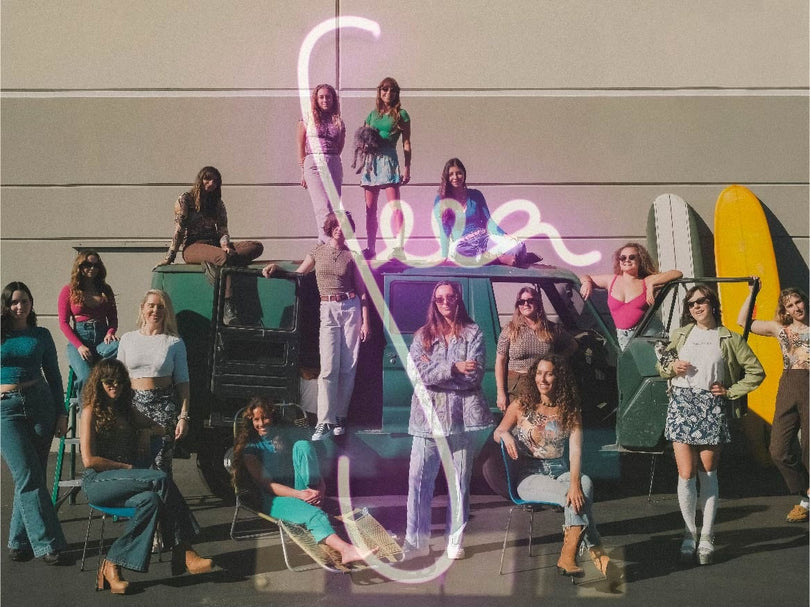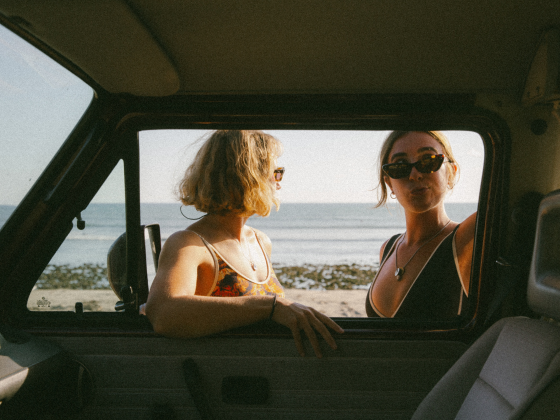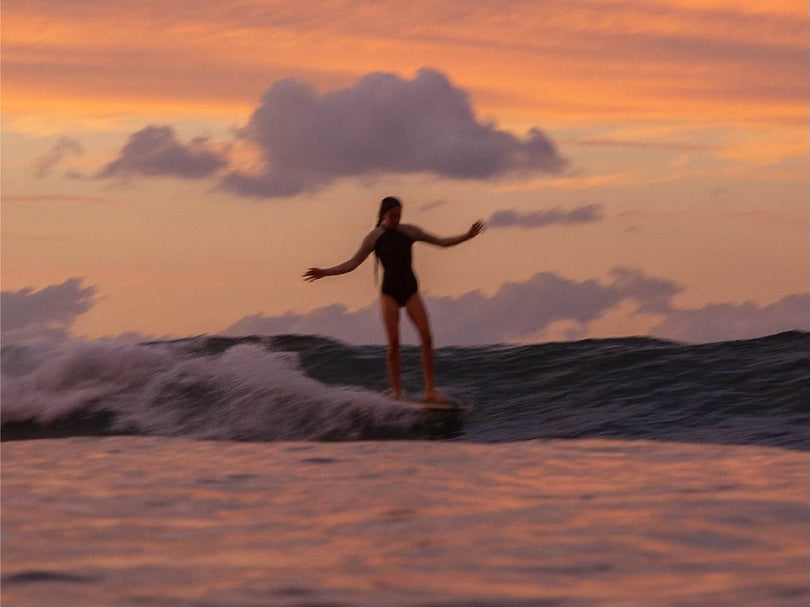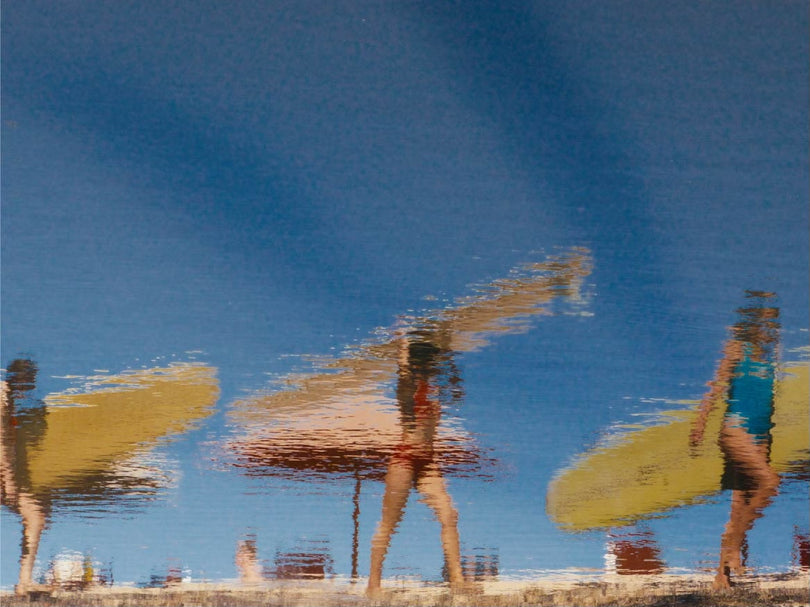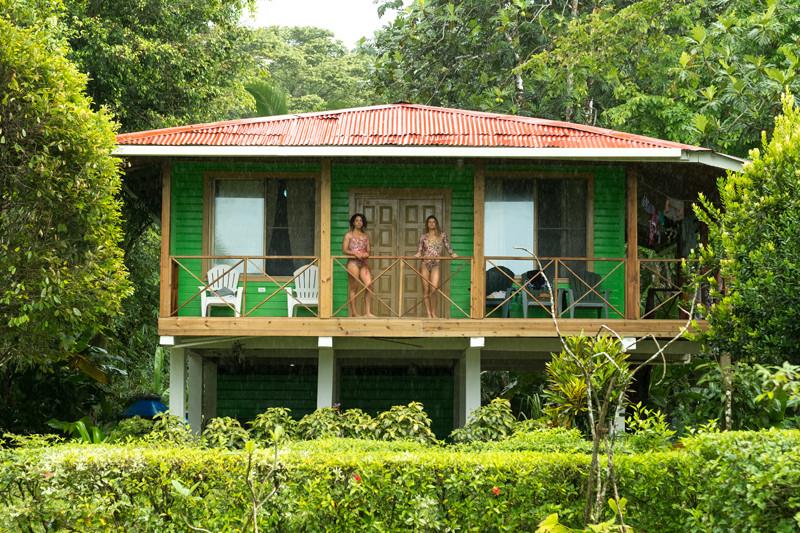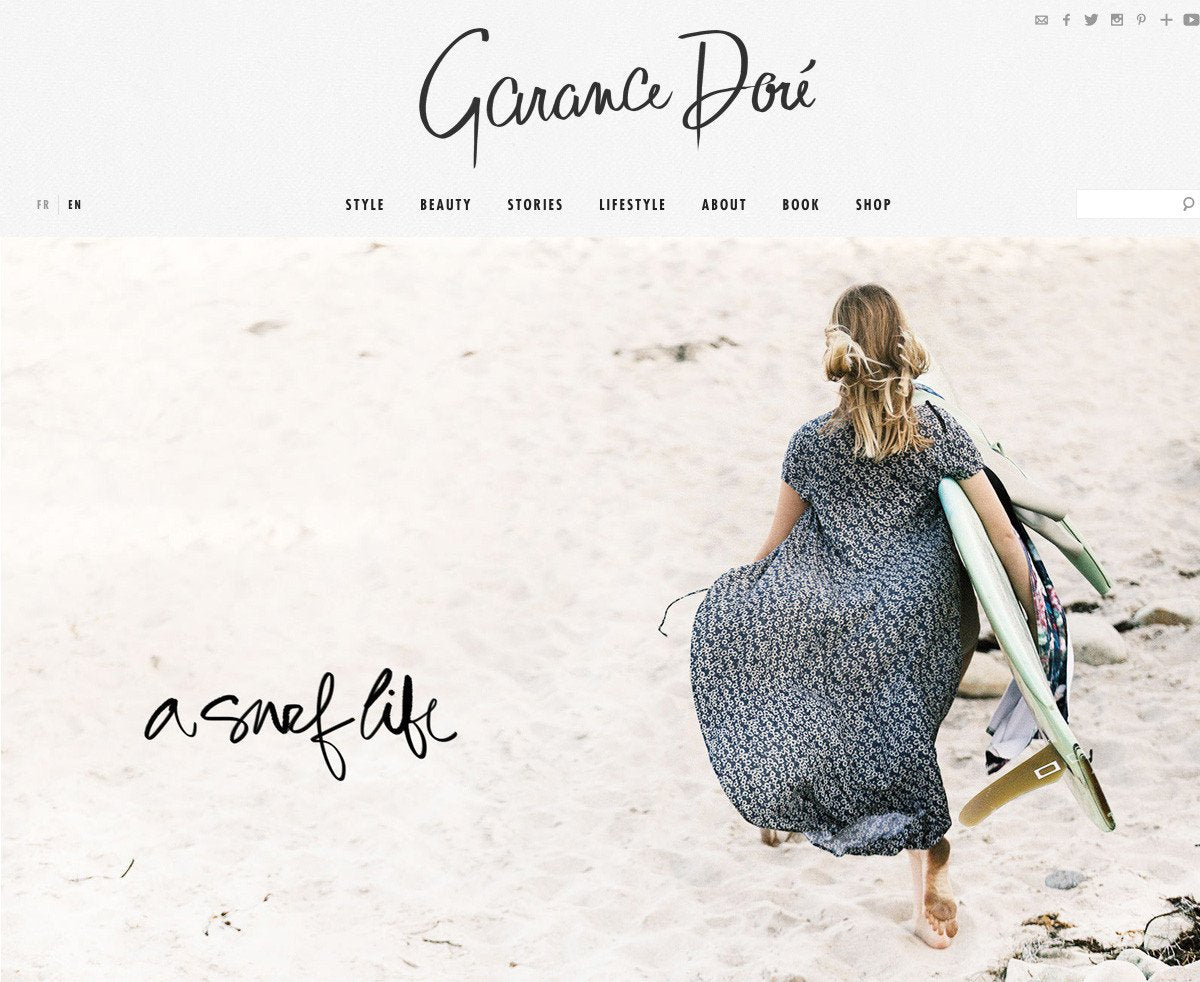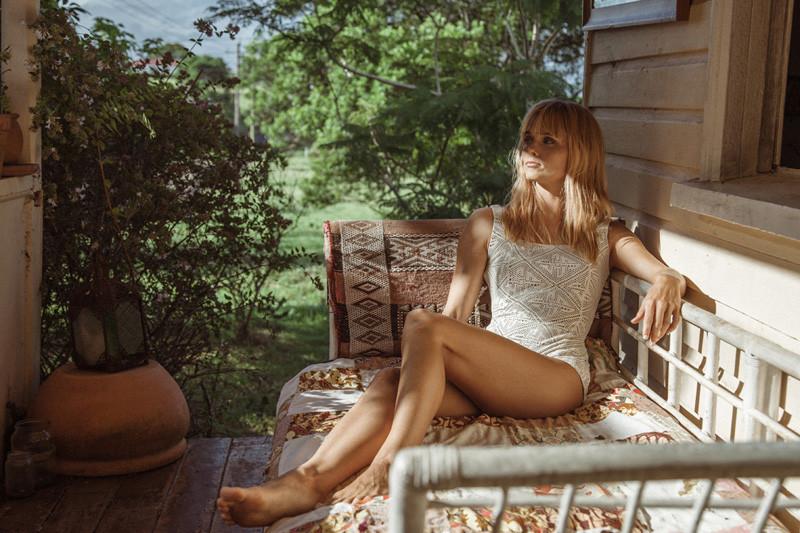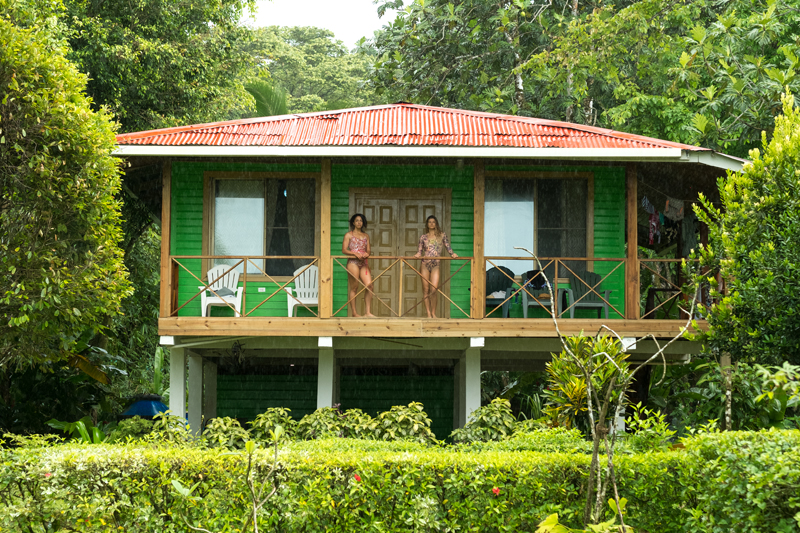 |
| Mele Saili and Leah Dawson stay dry in the rainforest at Red Frog Bungalows in Bocas Del Toro. Photo by Nick LaVecchia. |
Aside from Red Frog’s lush accommodations surrounded by endless greenery and its close proximity to fun waves, we were attracted to stay at Red Frog while filming "Seea in Panama," because of the resort’s commitment to sustainability and minimum negative impact on the environment. Leah Dawson checked in with Scott to find out more about why Bocas is a world class surf destination and the challenges of living off the electric grid.
Words by Leah Dawson
Tucked into the southwest corner of the Gulf of Mexico, there’s a collection of islands off the coast of Panama that are an adventurist’s dream. Air that smells and feels different, colors on houses you’ve never seen before, a culture unique, waves and landscape that make up a surfer’s grandest visions.
It takes people committed to a life off the beaten path to live in Bocas, one that is celebrated around water. Life is cheap for Americans and affordable for locals, whose language is Spanish, yet every person we met spoke to us in English.
I loved the adventure feeling running through my veins as I stepped off a boat onto a little island that would be home for a week. I imagined what it would have been like hundreds of years ago: possibly uninhabitable for most, as a boat is a necessity; though the tropical land is lush and fertile, a self-sustaining life on these islands is nothing short of a challenge. Now, with modern technology, our week-long home at the Red Frog Bungalows was powered 100 percent by solar, and rinsed with 100 percent rainwater. In this location, it not only makes sense to utilize the natural resources, it's necessary.
With stilted homes made from Indonesian materials, the land is kept as a jungle, a mass variety of plants and trees that fulfill a child’s "Jungle Book dreams."
We learned that with solid basic knowledge—and hard work—its easier, cheaper, and more efficient to utilize sustainable systems in Bocas. I liked having to pay attention to how much power and water I was using every day. Part of the reason we are in the plague of earthly destruction as a whole is that collectively we have become unaware of our direct effect, of how much we are consuming—and how much we are wasting. The directions “use only what you need” from Scott Balogh, the man behind Red Frog Bungalows, ring true for all of us around the globe.
What is something special about Bocas that drew you to this remote destination?
The perfect surf, culture, and surrounding ocean is what drew me to Bocas Del Toro. The surf in BDT is world class. We have point breaks, slabs, and beach breaks with a year-round water temperature of 80 degrees. I love the fact that our guests in our little resort have won a total of 19 world titles in the last three years. It is an incredible challenge to deliver perfect surf to these men and woman. They are used to surfing the best waves on the planet and are naturally jaded. It has been an extreme pleasure to constantly be creating memories of a lifetime for all of our guests.
BDT is also surrounded by water and on Bastimentos Island, where we are located, there are no roads. It is a very simple island life. I have not owned a car in over 15 years. I have two boats and a bicycle. There are not many places in the world where these are your primary forms of transportation.
Is sustainable living common in Bocas? Do you think your model is attainable for the average landowner in that area?
Sustainable living is common on the outer islands. Sustainable living is not cheap and unfortunately most of the locals cannot afford it. They also do not need it because utilities are still fairly cheap. We live away from town and have no central sewage or power grid. It is a necessity for us and rewarding to know that we do not need to receive any power or water bills. We always have water and power with proper checks and measures. Conservation is the key and I love to be in control of this aspect of the resort.
I don't feel that the system is attainable for people with central power and water. But I know it is attainable because there are many outer islands in Bocas Del Toro. Water catchment and solar are ways of life for everyone outside of Bocas.
Each morning we would make the 10-minute walk across the island to the mangrove side to catch our boat to the neighboring islands with the best surf on hand. It is a dream to speed across the channels and weave through swells. Pure adrenaline and laughter on the constant is the lifestyle that comes along with the well-curated Red Frog experience from the man behind the project.
I caught up with Scott for insight into his sustainable oasis.
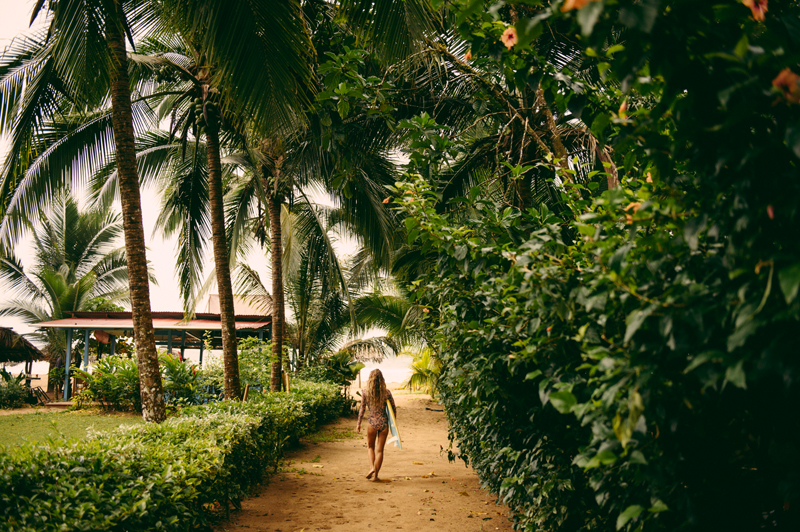 |
| Leah Dawson walks to the waves from Red Frog Resort. Photo by Dylan Gordon. |
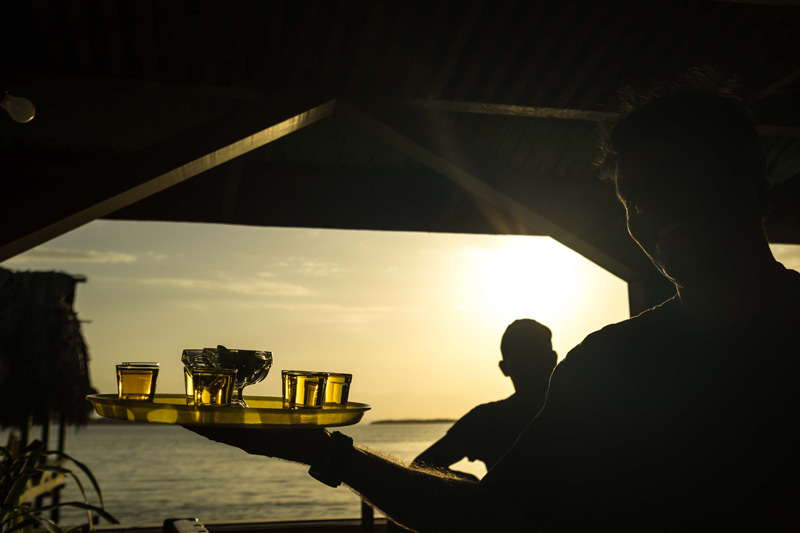 |
| The man behind Red Frog Resort, Scott Balogh serves up a round of tequila. |
What inspired you to create the Red Frog Bungalows sustainably, using sun and rain to run the show?
I graduated from the University of California, Santa Barbara and received my degree in natural resource management and solar energy. It was during my studies at UCSB that I found a real interest in low-impact living and trying to reduce our footprint on the environment. This was back in the early '90s before it was trendy and fashionable to say you were green. The course was really interesting to me and this really influenced me to look at alternate energy and applications that could be used around the world.
What’s the most challenging part of running a sustainable resort?
The logistics are the most challenging part of running Red Frog Bungalows. We are always fighting for either rain or sun. When it is raining we are consuming more power than we are producing, and when it is sunny we are consuming more water than we are collecting. Water is more difficult to collect and therefore more stressful. The sun is guaranteed to come out every day, but sometimes it does not rain for months. This El Niño has been extremely dry in Bocas Del Toro. We have had only five days of rain in three months.
What are the most rewarding parts?
The most rewarding part of the job is giving our guests some of the best days of their lives. There are so many days that go by in your life that you do not remember. It is very satisfying to hear people say it was the best surf of their life; or that it was the best vacation they have been on with their family. These are memories that last a lifetime and beyond and really are special days in their lives. This is what I am most passionate about at Red Frog Bungalows: guest experience!
I graduated from the University of California, Santa Barbara and received my degree in natural resource management and solar energy. It was during my studies at UCSB that I found a real interest in low-impact living and trying to reduce our footprint on the environment. This was back in the early '90s before it was trendy and fashionable to say you were green. The course was really interesting to me and this really influenced me to look at alternate energy and applications that could be used around the world.
What’s the most challenging part of running a sustainable resort?
The logistics are the most challenging part of running Red Frog Bungalows. We are always fighting for either rain or sun. When it is raining we are consuming more power than we are producing, and when it is sunny we are consuming more water than we are collecting. Water is more difficult to collect and therefore more stressful. The sun is guaranteed to come out every day, but sometimes it does not rain for months. This El Niño has been extremely dry in Bocas Del Toro. We have had only five days of rain in three months.
What are the most rewarding parts?
The most rewarding part of the job is giving our guests some of the best days of their lives. There are so many days that go by in your life that you do not remember. It is very satisfying to hear people say it was the best surf of their life; or that it was the best vacation they have been on with their family. These are memories that last a lifetime and beyond and really are special days in their lives. This is what I am most passionate about at Red Frog Bungalows: guest experience!
 |
| Animals in the jungle. Photo by Nick LaVecchia. |
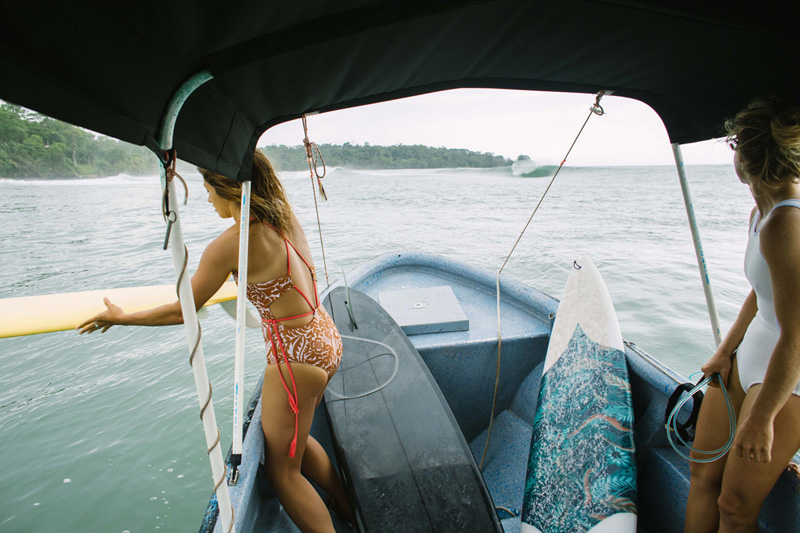 |
| Traveling by water and getting ready to jump in. Mele wears the Anglet One-Piece in Selva. Leah wears the Martinique One-Piece. Photo by Nick LaVecchia. |
What is something special about Bocas that drew you to this remote destination?
The perfect surf, culture, and surrounding ocean is what drew me to Bocas Del Toro. The surf in BDT is world class. We have point breaks, slabs, and beach breaks with a year-round water temperature of 80 degrees. I love the fact that our guests in our little resort have won a total of 19 world titles in the last three years. It is an incredible challenge to deliver perfect surf to these men and woman. They are used to surfing the best waves on the planet and are naturally jaded. It has been an extreme pleasure to constantly be creating memories of a lifetime for all of our guests.
BDT is also surrounded by water and on Bastimentos Island, where we are located, there are no roads. It is a very simple island life. I have not owned a car in over 15 years. I have two boats and a bicycle. There are not many places in the world where these are your primary forms of transportation.
Is sustainable living common in Bocas? Do you think your model is attainable for the average landowner in that area?
Sustainable living is common on the outer islands. Sustainable living is not cheap and unfortunately most of the locals cannot afford it. They also do not need it because utilities are still fairly cheap. We live away from town and have no central sewage or power grid. It is a necessity for us and rewarding to know that we do not need to receive any power or water bills. We always have water and power with proper checks and measures. Conservation is the key and I love to be in control of this aspect of the resort.
I don't feel that the system is attainable for people with central power and water. But I know it is attainable because there are many outer islands in Bocas Del Toro. Water catchment and solar are ways of life for everyone outside of Bocas.
Thank you Scott! For more information about Red Frog Resort, visit the website HERE.

